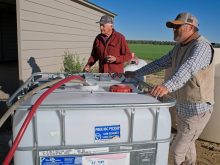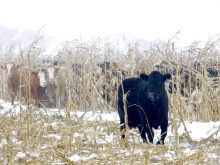With plenty of summer storms bringing high winds and hail to the Prairies this summer, there has been more Goss’s wilt showing up in Manitoba fields. A visual survey of 142 corn fields across Manitoba in August and September identified Goss’s wilt in 56 of them.
The inoculum for Goss’s wilt is present most years in Manitoba fields that have been growing corn for many years, but conditions have to be right to produce an outbreak of the bacterial pathogen.
“For Goss’s wilt to develop there must be an abrasion of the leaf. It needs to be ripped, or sandblasted, or hailed on to rip the infection site and then it needs moisture,” says DuPont Pioneer agronomist Michael Weir. “This year we had a lot of storms, and moisture throughout August and September, so that’s why we’ve seen an outbreak of it this year in a lot of areas.”
Read Also

Claas brings 1000 Series SP forage harvesters to Canada
In mid-August, Claas unveiled its new line of Jaguar forage harvesters at an event in Visalia, California, deep in the heart of that state’s dairy region.
The first line of defence against Goss’s wilt is rotation. “We definitely find Goss’s wilt is more severe in fields that have been continuously growing corn,” says Holly Derksen, field crop pathologist with Manitoba Agriculture.
Equally important is managing corn residue, which provides a safe harbour for the inoculum to wait for favourable conditions. “The take home message is to get residue incorporated into the ground so it can start breaking down in the soil,” says Weir. “Ensuring a good rotation and managing residue can lower the amount of inoculum present but doesn’t eliminate it entirely. As well, if someone close by has some infected residue on top of the ground and you get a wind event, that residue will transfer to neighbouring fields, so the disease can move from field to field.”
A number of corn hybrids that offer good resistance to Goss’s wilt. “I definitely recommend growing a resistant hybrid in areas where Goss’s wilt is established, but growers should be aware that information is not always included in the brochure they get from their seed company, so they may need to go back to their seed company and ask more questions about the hybrids,” says Derksen. “They also should keep in mind that we still don’t have third party data for Goss’s wilt resistance so they can’t compare a resistance rating from one company to a rating from another company. They can only compare within the company.”
A spreading problem
Goss’s wilt is also showing up in non-traditional corn growing areas in Northwestern and the Interlake regions of Manitoba, and as far west as Moosomin, Sask. Growers may not necessarily identify it in their fields, so it’s important to know the symptoms. Most likely the infection will start at the field edges, says Derksen. “They may often notice a spot where the plants are starting to wilt or prematurely ripen,” she says. “We don’t have the systemic version of Goss’s wilt in Manitoba so we don’t see it early in the season where it’s wilting the young plants, we only usually see it showing up mid-season or later and you notice it on the leaves first.”
There is often some discolouration present, which initially looks like a water-soaked spot, but which will then turn a tan colour. The infected area will often be shiny, especially in sunlight, because Goss’s wilt is caused by bacteria, which ooze an exudate that has a shiny appearance. On the margins of the lesions there will be a freckling pattern flush with the leaf surface, not raised or bumpy. To be sure, growers can send samples off to a diagnostic lab.
In most cases Goss’s Wilt isn’t causing significant yield losses. “I don’t think in Manitoba, we’ve had very many situations where it has taken a lot of yield away but at the same time, it’s difficult to measure because generally it is in conjunction with adverse environmental events, so it’s hard to know whether yield loss is from Goss’s wilt or as a result of weather conditions,” says Derksen. “I would say this year there might have been a couple of growers who saw yield loss because we did see some more severely infected fields but I would say those growers are still few and far between. We do not see the same yield loss as in the U.S. because they commonly have the systemic version of the disease, in addition to the foliar version that we have.”
There are no options to control Goss’s wilt once it develops and infects plants. “There is nothing you can spray on an infected plant with Goss’s wilt to fix it,” says Weir. “It’s not a fungal disease so fungicides are ineffective.”
In some cases Goss’s wilt inoculum can reside in grassy weeds like foxtail and barnyard grass, so controlling these weeds can eliminate alternative disease hosts. Understanding the life cycle of Goss’s wilt can also help growers manage it better, says Weir. “It was a big year for Goss’s wilt this year so growers might be worried about next year, but all we’ve really done is increase the inoculum in the soil,” he says. “If we don’t have a wet August or September next year, we might not see that much Goss’s wilt pressure. It’s just important to understand the disease and the available management practices.”
















